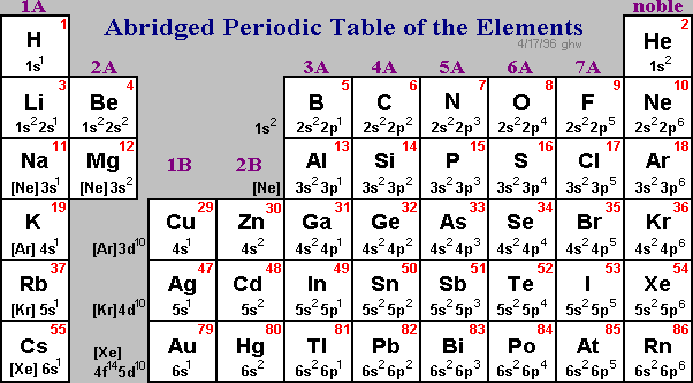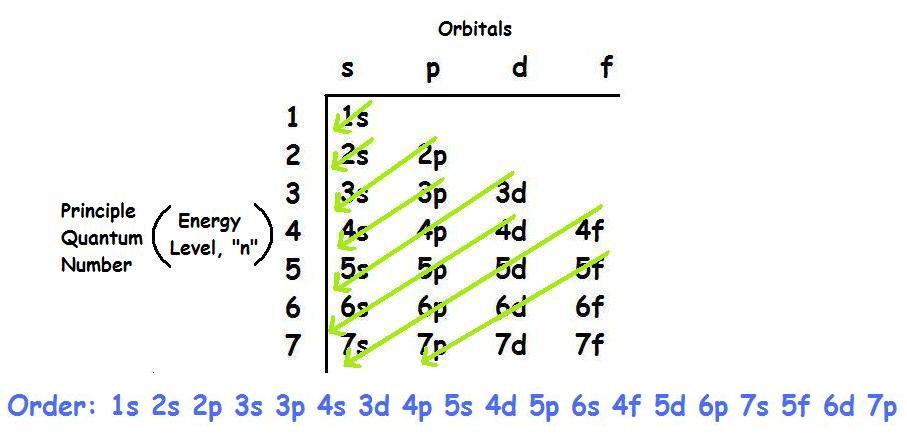Introduction
There are four principle orbitals (s, p, d, and f) which are filled according to the energy level and valence electrons of the element. All four orbitals can hold different number of electrons. The s-orbital can hold 2 electrons, and the other three orbitals can hold up to 6, 10, and 14 electrons, respectively. The s-orbital primarily denotes group 1 or group 2 elements, the p-orbital denotes group 13, 14, 15, 16, 17, or 18 elements, and the f-orbital denotes the Lanthanides andActinides group. The main focus of this module however will be on the electron configuration of transition metals, which are found in the d-orbitals (d-block).
The electron configuration of transition metals is special in the sense that they can be found in numerous oxidation states. Although the elements can display many different oxidation states, they usually exhibit a common oxidation state depending on what makes that element most stable. For this module, we will work only with the first row of transition metals; however the other rows of transition metals generally follow the same patterns as the first row
The Electron Configurations of Atoms
The electron configuration of an atom shows the number of electrons in each sublevel in each energy level of the ground-state atom. To determine the electron configuration of a particular atom, start at the nucleus and add electrons one by one until the number of electrons equals the number of protons in the nucleus. Each added electron is assigned to the lowest-energy sublevel available. The first sublevel filled will be the 1s sublevel, then the 2s sublevel, the 2p sublevel, the 3s, 3p, 4s, 3d, and so on. This order is difficult to remember and often hard to determine from energy-level diagrams such as Figure 5.8A more convenient way to remember the order is to use Figure 5.9. The principal energy levels are listed in columns, starting at the left with the 1s level. To use this figure, read along the diagonal lines in the direction of the arrow. The order is summarized under the diagram.
| FIGURE 5.9 The arrow shows a second way of remembering the order in which sublevels fill. |
For helium (atomic number 2), which has two electrons, the electron configuration is:
He: 1s2Two electrons completely fill the first energy level. Because the helium nucleus is different from the hydrogen nucleus, neither of the helium electrons will have exactly the same energy as the single hydrogen electron, even though all are in the 1s sublevel. The element lithium (atomic number 3) has three electrons. In order to write its electron configuration, we must first determine (from Figure 5.9) that the 2s sublevel is next higher in energy after the 1s sublevel. Therefore, the electron configuration of lithium is:
Li: 1s22s1Boron (atomic number 5) has five electrons. Four electrons fill both the 1s and 2s orbitals. The fifth electron is added to a 2p orbital, the sublevel next higher in energy (Figure 5.9). The electron configuration of boron is:
B: 1s22s22p1Table 5.2 shows the electron configurations of the elements with atomic numbers 1 through 18. The electron configurations of elements with higher atomic number can be written by following the orbital-filling chart in Figure 5.9.
| Element | Atomic number | Electron configuration |
|---|---|---|
| hydrogen | 1 | 1s1 |
| helium | 2 | 1s2 |
| lithium | 3 | 1s22s1 |
| beryllium | 4 | 1s22s2 |
| boron | 5 | 1s22s22p1 |
| carbon | 6 | 1s22s22p2 |
| nitrogen | 7 | 1s22s22p3 |
| oxygen | 8 | 1s22s22p4 |
| fluorine | 9 | 1s22s22p5 |
| neon | 10 | 1s22s22p6 |
| sodium | 11 | 1s22s22p63s1 |
| magnesium | 12 | 1s22s22p63s2 |
| aluminum | 13 | 1s22s22p63s23p1 |
| silicon | 14 | 1s22s22p63s23p2 |
| phosphorus | 15 | 1s22s22p63s23p3 |
| sulfur | 16 | 1s22s22p63s23p4 |
| chlorine | 17 | 1s22s22p63s23p5 |
| argon | 18 | 1s22s22p63s23p6 |
Order of Filling the Subshells
The following image shows the order for filling the subshells:
Determining Electron Configuration
One of the skills you will need to learn to succeed in freshman chemistry is being able to determine the electron configuration of an atom. An electron configuration is basically an account of how many electrons there are, and in what orbitals they reside under "normal" conditions. For example, the element hydrogen (H) has one electron. We know this because its atomic number is one (1), and the atomic number tells you the number of electrons. Where does this electron go? The one electron of hydrogen goes into the lowest energy state it possibly can, which means it will start at "level" one and goes into "s" orbitals first. We say that hydrogen has a "[1s1]" electron configuration. Looking at the next element on the Periodic Table --helium, or He -- we see it has an atomic number of two, so two electrons. Since " s" orbitals can hold up to two electrons, helium has an electron configuration of "[1s2]".
What about larger atoms? Let's look at carbon, with an atomic number of 6. Where do its 6 electrons go?
- First two: 1s2
- Next two: 2s2
- Last two: 2p2
We can therefore say that carbon has the electron configuration of "[1s22s22p2]".
The table below shows the subshells, the number of orbitals, and the maximum number of electrons allowed:
| Subshell | Number of Orbitals | Maximum Number of Electrons |
|---|---|---|
| s | 1 | 2 |
| p | 3 | 6 |
| d | 5 | 10 |
| f | 7 | 14 |
Sometimes you will see the notation: "[Ne]3s23p6", which means to include everything that is in neon (Ne, 10) plus the stuff in the "3"-level orbitals.


A tuff concept explained in a easy way.... Thnx sir....
ReplyDeletethank you ,glad that it was of some help
DeleteA dissertation, or thesis paper, is comprised of chapters, graphs, tables, headings, and subheadings. Above all, it is a research paper and contains wide array of facts collected from reference books, notes, etc. See more answers for mastering chemistry
ReplyDeleteThis blog aware me about different programs which can become very useful for our friends and kids. Few websites provide combined courses and few of the are separately for single subject. Glad to get this information.FORTIAP 25D
ReplyDelete